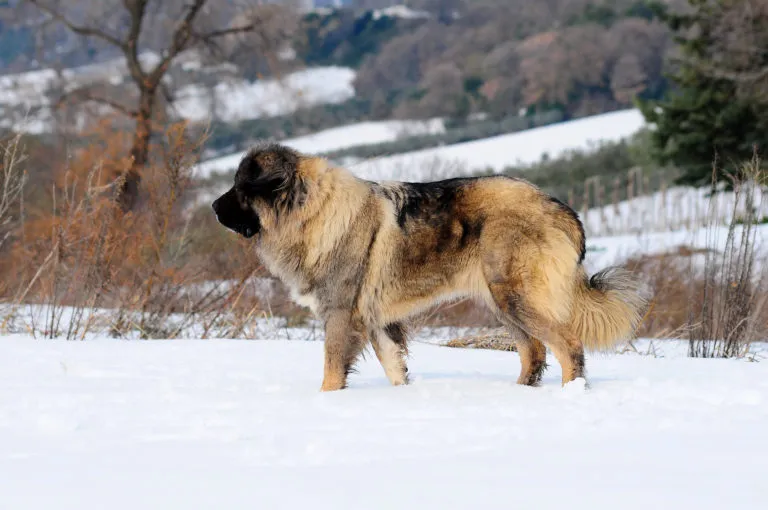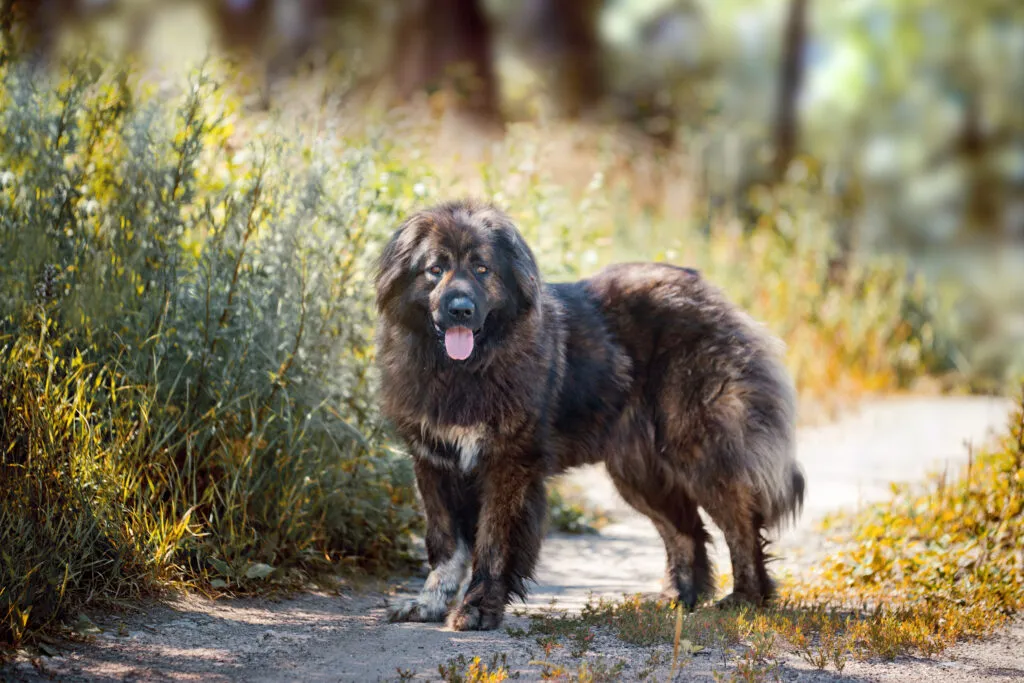Medium Size Poodle
Protecting the herd and guarding the home are deeply ingrained in the nature of this guard dog. Combined with its imposing size and immense power, this protective instinct can become dangerous. The Caucasian Shepherd Dog (or Caucasian Ovcharka) belongs exclusively in the hands of experienced dog owners.

© Ricant Images / stock.adobe.com
The Caucasian Shepherd is independent at heart and it often reminds you it doesn’t need you, but chooses to stay
Just the sight of this bear-like watchdog is likely to deter most intruders. A fully grown male dog can weigh upwards of 75kg, with a shoulder height of up to 70cm. Females, being somewhat smaller and lighter, still present an impressive figure with a size of 68 to 72cm and a weight between 45 and 60kg.
While the current breed standard no longer differentiates, two distinct types based on regions of origin can still be observed:
The FCI’s breed standard, maintained by Russia, merges these two types, allowing for variations in size and coat length. Thus, both short-haired and long-haired dogs, and intermediate varieties, are permitted. The three possible coat types include:
All three types feature coarse hair with dense undercoats, typically lighter in tone than the top coat. Acceptable colours include various grey shades, straw yellow, white, earthy tones, and combinations such as striped, brindle, spotted or speckled. Black or black-spotted dogs are considered a fault in the standard.
The diverse colour variants and body types make sense given the vast region of origin for this breed. Stretching from the former USSR to the borders of Iran and Turkey, with a focus on the Caucasus region between the Black Sea and the Caspian Sea, the Caucasian Shepherd Dog is widespread in Armenia, Azerbaijan, Dagestan, and North Caucasus, though still rare in Western Europe and America.
The Caucasian Shepherd Dog is an ancient type, serving herders for over 600 years by safeguarding their flocks. It has reliably and fearlessly defended against predators like wolves and bears, as well as thieves. Introduced to the former GDR and other Eastern Bloc countries as military guard dogs in the mid-20th century, they eventually spread to other parts of Europe and America. The first breed standard was established under Russian guidance, and in 1984, the Caucasian Shepherd Dog was officially recognised by the FCI.
Outside its homeland, the breeding of the Caucasian Shepherd Dog is still in its early stages. Nevertheless, this bear-like breed has garnered a dedicated following, committed to preserving its impressive traits with passion and expertise. In addition to the breed’s characteristics, health is a primary focus. Although generally robust and healthy, like other large breeds, Caucasians can experience joint issues (elbow and hip dysplasia, knee problems). Prospective puppy buyers should look for genetic test results and ensure that both parents are free from hereditary eye diseases such as ectropion and entropion.
Self-confidence is certainly not lacking in this imposing breed from the Caucasus. Known also as the Caucasian Ovcharka, Russian Bear Dog, or Caucasian Mountain Dog, it can manage wonderfully on its own. As an original guard dog from the former USSR, it is used to living outdoors with its herd for days, guarding and protecting it independently. Cold, wind, or rain don’t bother it, and it will not shy away from a fight with wolves or bears targeting the herd.
No wonder it finds it hard to submit. Even as a family dog, it retains its independence and often shows its owners that it doesn’t necessarily need them. Unlike breeds like Collie, Labrador or Boxer, which naturally have a strong “will to please,” the Caucasian Shepherd doesn’t need to please its humans.
This autonomous four-legged friend requires a lot of consistency, empathy, time, and patience in its training. It’s almost self-evident that such a dog should only be in the hands of very experienced dog owners.
Under knowledgeable care and appropriate conditions, it will develop into an incredibly loyal partner and reliable watchdog. When integrated into the family from the start and assigned a role that suits its nature, this imposing Bear Dog can be balanced, affectionate, and sensitive without being overly demanding.
With early socialisation and consistent guidance, it can get along well with children in the family. However, it typically doesn’t get along well with other dogs or cats due to its dominant nature.
 © Julia Shepeleva / stock.adobe.com
© Julia Shepeleva / stock.adobe.com
Though calm and loving within the family, it remains wary and aloof towards strangers. Anyone who enters its territory uninvited will face a fearless and battle-ready watchdog, prioritising the safety of its family. The inherent territorial awareness and natural protective instinct of this breed should never be underestimated or further encouraged, for instance, through protection dog training, as it can lead to uncontrollable consequences.
To ensure the dog poses no threat to neighbours and strangers, a secure and stable fence around the property is essential. Additionally, a companion dog training can often help ensure harmonious coexistence between humans and the Caucasian Shepherd.
How intensive coat care for a Caucasian Shepherd Dog is depends on its coat length. Longer-haired dogs naturally require more coat care than their short-haired counterparts. However, compared to training, coat care is relatively easy. Thorough brushing twice a week is usually sufficient to remove dirt and dead hair. Regular trimming of nails and cleaning and checking ears and teeth are also necessary.
The stubbornness of a Caucasian Shepherd can make coat care challenging. Therefore, start coat care early, teaching the puppy to sit still.
Proper nutrition significantly impacts our pets’ health. But what food is right for such a large dog like the Caucasian Shepherd Dog?
Firstly, a Caucasian Shepherd eats less than its size suggests. This guard dog, accustomed to a harsh climate with little food, doesn’t require much – even a couple of days without food doesn’t seem to bother it.
Nevertheless, owners should stick to regular feeding times, giving their adult dog food twice a day with fresh meat, some vegetables, fruit or rice. Patience is needed to get a Caucasian Shepherd to eat – don’t be disheartened if it is picky and spits out treats.
Find out what your dog likes best: homemade food, raw food (BARF) or ready-made dry or wet dog food. A combination is also possible – make sure not to overwhelm your dog. Introduce new foods gradually and give the dog time to adjust. Constant changes can confuse your dog and negatively impact its digestion.
Stick to a diet that your Caucasian Shepherd enjoys and finds digestible. The content of the food is more crucial than the form. Ensure your dog gets all necessary nutrients for its age and condition through its diet.
Those considering purchasing this unique guard dog have likely thought it through carefully. The Caucasian Shepherd Dog is not easy to handle and is only moderately suitable as a family dog. Thoroughly researching and confirming that you can handle this breed is essential.
The search for a suitable breeder and an appropriate puppy can be challenging, with potentially long travel distances or wait times for the next litter. Breeders also frequently test potential buyers rigorously to ensure they are suitable owners.
Convince both yourself and the breeder that you meet all requirements of a suitable owner. Don’t be offended by personal questions about your living environment, work, hobbies, neighbours, and friends. These questions help the breeder determine if a Caucasian Shepherd Dog fits into your life. If the breeder discourages you from purchasing this breed, consider their advice seriously. In the wrong hands, a Caucasian Shepherd Dog can become an uncontrollable danger.
Are you ready to put up a two-metre-high fence around your property? Would you like to seclude yourself from your neighbours? Are you okay with being awakened in the night by a loud bark because someone or even just a hedgehog walked past your property?
If you can’t answer these questions with a clear “yes,” perhaps reconsider buying a Caucasian Shepherd Dog. It may sound exaggerated, but this breed is not a dog for a casual dog lover. It takes courage, knowledge, and strength of character to raise and train this impressive dog.
Even though a Caucasian puppy may look cute and cuddly, it will soon grow into a large and powerful dog, possibly outmatching you in strength. Friends or neighbours can no longer simply drop by, as even well-socialised and trained Caucasians remain forever wary of strangers. It doesn’t like being touched by strangers and should never be pet by your friends without your approval.
The Caucasian Shepherd Dog is not a dog that fits easily into your life, requiring significant adjustments on your part. Only by fully embracing its nature as a guard dog, granting it the freedoms and tasks it needs, and guiding it with firm and loving consistency, will you find joy and a reliable partner in this breed.
| Special Features: | The Caucasian Shepherd Dog wants to fulfil its purpose of guarding its family. It is not suitable for pure indoor living and needs a large, fenced property |
| Character: | watchful, fearless, reliable, sensitive |
| Shoulder Height: | males: 68-75cm females: 64-70cm |
| Weight: | males: min. 50kg females: min. 45kg |
| Coat: | long, medium-length, or short-haired, coarse structure, thick undercoat, varying in grey, straw yellow, white or earthy tones |
| Coat Care: | low maintenance, occasional brushing |
| Exercise: | low to moderate need, e.g., walks or autonomous property guarding |
| Beginner Dog: | no |
| Barks: | barks fairly often, loud deep voice |
| Life Expectancy: | approx. 10-12 years |
| Typical Health Issues: | hip & elbow dysplasia, eyelid deformities |
| Price: | starting from approx. £1,000 |
| FCI Group: | Group 2: Pinscher & Schnauzer – Molossoide |
| Origin: | Russia |
Fans of the Bearded Collie agree that those who aren't familiar with this dog breed simply have to get acquainted with it. And those who have experienced how a Bearded Collie bolts across meadows with its flowing fur, how it rolls around full of energy and joy and how it attentively and observantly takes into account its owners wishes become simply addicted to this original dog breed and its unique charm.
The Goldendoodle isn't a breed, but a pairing between Golden Retrievers and Medium or Standard Poodles. Marketed as a low-maintenance dog for allergy sufferers, this hybrid is enjoying increasing popularity amongst dog lovers, similar to the Labradoodle.